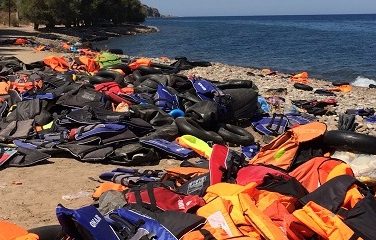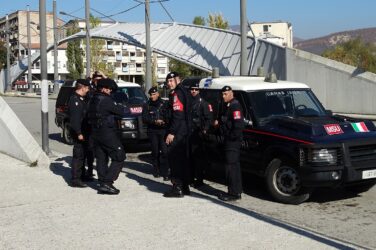European integration is facing a new challenge from the Russian-led Customs Union. But can Putin’s process match up to the EU in building economic and trade links?
Russian-Ukrainian relations hit bottom following intensely tightened border checks on Ukrainian goods by Russian authorities. A warning to Ukraine’s government to abandon ongoing association with the EU and reorient itself eastwards, President Putin’s strategy of economic integration faces problems of its own. Russia’s actions against members of its Customs Union raises question over how successful multilateral projects framed around a punitive dominant player can actually be.
Integration at all costs
Trade disputes between Russia and Ukraine aren’t new. In 2009, the two sides clashed over natural gas prices, culminating in a thirteen-day supply block that affected the whole of South-Eastern Europe. The most recent dispute is a political signal to Kiev to give up flirting with Brussels and abandon talks over the EU-Ukraine Association Agreement and Deep and Comprehensive Free Trade Agreement (DCFTA). These documents would grant Ukraine unrestricted access to the European single market with particular benefits expected for Ukraine’s clothing, wood, metallurgical, food and machine-building industries.

On the other border, the Russian side eagerly warns Ukraine about growing imports from the EU, pointing at the risk of increasing the already large foreign account deficit; with Russia being the largest holder of Ukrainian foreign debt. It is far from a secret that Russia is keen to welcome Ukraine as the fourth member of the Customs Union created in 2010, until now consisting of Russia, Belarus and Kazakhstan. This economic integration among Soviet successor nations is a trajectory that had already been launched during the very first years after the breakup of the Soviet Union and largely shapes Russia’s relations towards with its neighbours.
On paper, the Eurasian Customs Union is the most successful project of post-Soviet integration to date.
Under the subsequent professionalisation of Russian foreign policy-making under Putin, alongside the clinical application of energy trade as a policy tool, Russian moves to integrate the Customs Union seem to be on good grounds for success. The latest round of post-Soviet integration has its basis in the Commonwealth of Independent States (CIS) and several economic agreements, first established to limit the disintegration processes unleashed by the breakup of the Soviet Union.
The future single market among the Custom Union members is under discussion as well as the so-called “Eurasian Union”, a political and economic association modelled after the European Union’s policy of integration. Given President Putin’s eager attempts at binding post-Soviet countries to Russia, the most recent trade war with Ukraine fits into the next stage of institutional development framed around ensuring Russia retains its regional dominance.
Potash wars
On paper, the Eurasian Customs Union between Russia, Kazakhstan and Belarus is the most successful project of post-Soviet integration to date. Common External Tariffs were implemented; a Customs Code introduced, and trade between the three members increased by almost one third during the first year after it was established. All these steps worked to ensure that Russia still had economic and political influence over its neighbours. Despite these achievements, a current dispute between Russia and Belarus demonstrates that the absence of fundamental rules and trust undermines its continuing development.
The conflict began with an announcement from Vladislav Baumgertner, CEO of the Russian company Uralkali, the world’s biggest producer of potash, which is used for agricultural fertilisation. The Russian announced the decision to dissolve a long-lasting export alliance with the Belarusian state company Belaruskali, thus triggering concerns about price drops.
To put this into context, potash exports contribute 20 per cent of Belarus’ state budget. Price variations can therefore seriously hurt the country’s economic and fiscal performance. After accepting an invitation to come to Belarus for talks, Baumgertner was arrested in Minsk and accused of having committed fraud and caused damages amounting to USD 100 million. Russia consequently decreased oil supplies to Belarus by 25 per cent, officially referring to pipeline reconstruction works, and even launched an import prohibition on pork from its western neighbour. This episode demonstrates the punitive nature of trade relations within the Customs Union and the likelihood of escalation among its members.
Far from unity
Adhering the Kremlin’s rules does not guarantee escaping Russia’s wrath and preventing disputes with countries that followed its plan for economic integration. Belarus’ motivation for joining the Customs Union offers one explanation for why disagreements between the Union’s members tend to escalate.
Throughout 2009 and 2010, Belarus used the Customs Union as leverage in negotiations over preferential energy trade terms with Russia. Rather than being based on common interest, the notion of the Custom Union was a tool for political purposes. In the case of Belarus, after months of confrontation, the Belarusian Government even attempted to replace Russian imports from Gazprom with Venezuelan oil shipments and suffered a propaganda campaign against President Lukashenko on Russian TV. Following the elections in 2010, Belarus gave in and joined the Customs Union and the Kremlin agreed on duty-free oil supplies.

It’s important to note that, unlike European integration, legal or political reforms are not required for prospective Customs Union members. The linking of economic arrangements with human rights or democratic principles is a peculiarly European phenomenon. But in the absence of transparency and anti-corruption measures lies the failure to establish a common system of rules and measures to safeguard free trade, leaving an open space for arbitrary decisions that undermine the Union. Highly authoritarian regimes which assemble most power in the hands of one man, as in Belarus’ case, are therefore able to disrupt multilateral trade and cooperation when it suits their short-term interest.
Eurasian vs European integration
The European model of economic integration seems to resemble a very different approach. Accession to the EU requires far-reaching reforms in order to ensure that everybody plays by the same rules. The countries in Central and Eastern Europe moved from central planning to free market systems during their transition years and commenced the accession process to the EU, thus conducting both political dialogue and economic liberalisation measures.
The considerable costs incurred by Central and East European countries in achieving compliance with EU norms and standards should not be underestimated, nor should the impact of the radical changes to their legal and economic systems felt on an institutional level. But in the course of several enlargement rounds, the eastward expansion of the European Union provided new opportunities to companies and variety for consumers, while also revealing issues of discrepancy among EU members such as transnational labour migration that can be dealt with, albeit imperfectly, within the stable political framework of the European Union.
It is this higher political goal of European integration that has supported trade integration of many of the former Soviet states. Free movement of goods, services, capital and persons is an enormous ambition in order to stimulate competition, market efficiency and innovation over a wide geographical area, necessitating a strong political will on the part of its partners.
This is not to say that European economic integration in the former states of the Eastern Bloc has been a pure success story. Regional differences in economic development are likely to exist for a long time and the process remains under pressure from national political forces, despite members signing up to the existing set of rules. Still, Russia’s notion of economic integration reveals a critical lack of transparency in favour of a political agenda to establish its own dominance in an expanded Customs Union. As long as Russia relies on punishing countries in its proximity and building economic blocs based exclusively on national interests, the institutions of Eurasian Integration will be limited in their long-term attractiveness in Eastern Europe.
Cover photo: Pierre Boulle (CC BY-NC-SA 2.0)








